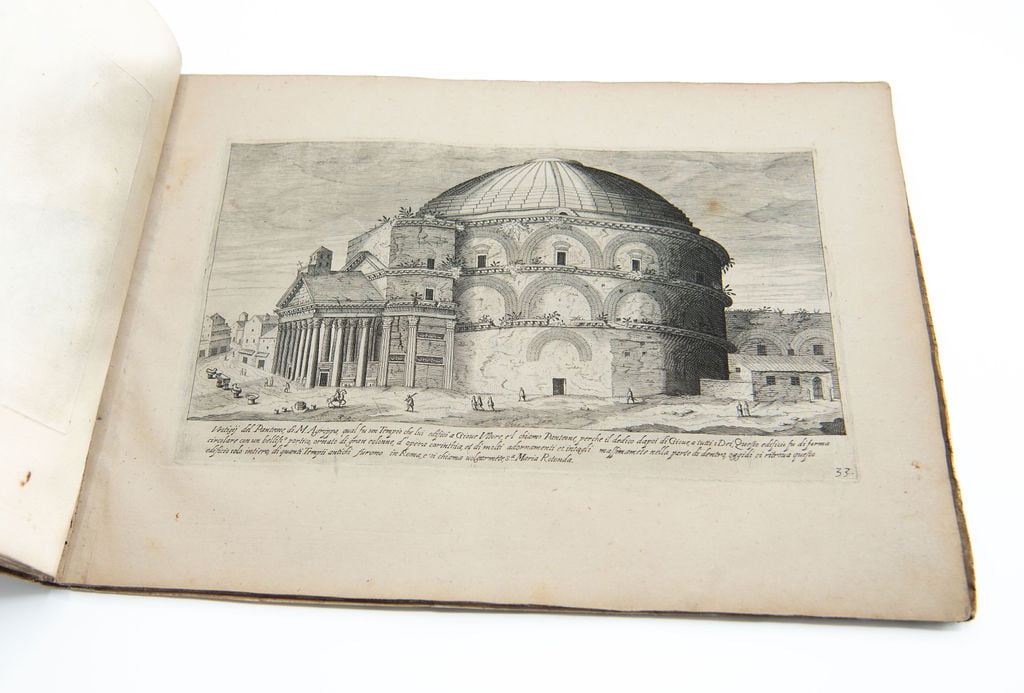SADELER, Aegidius.
ROME FINELY ILLUSTRATED
Vestigi delle antichità di Roma, Tivoli, Pozzuolo et altri luochi.
Prague, Aegidius Saedeler, 1606.£7,500.00
FIRST EDITION. Oblong folio. Engraved t-p with personification of Time and Fame, and caryatids + 50 engraved plates of antiquities and views of Rome and surrounding areas. Variable mostly light age browning, couple of fore-edges a little softened, untrimmed, intermittent light water stain to outer blank margins, some ll. reinforced at gutter. A good, large copy in fine contemporary limp vellum, traces of ties, double gilt ruled, gilt large fleurons to outer and inner corners, gilt lozenge-shaped centrepiece, spine gilt, bit creased and soiled, couple of small repairs to lower edges. C19 armorial bookplate ‘de Urcher’ to front pastedown, C18 armorial bookplate of Baron von Wiesenhutten to ffep. In folding box.
Attractively bound copy of the first edition of this series of fine engraved Roman views—a scarce Prague imprint by a major master-engraver. Its author, the Flemish Aegidius II Sadeler (1570-1629), was court engraver to the Emperor Rudolf II; many of his fine engravings were faithful copies of works by Dürer, Titian, Raphael and Tintoretto. ‘Vestigi’ stands halfway between a guide to Rome and a series of picturesque views. Mostly engraved by Marco Sadeler, 27 plates are reduced copies of views from Étienne Duperac’s successful ‘I vestigi dell’antica Roma’ (1575); 4 more were adapted after drawings by Jan Breughel the Elder, 3 after drawings by Pieter Stevens, and a handful inspired by as yet unidentified sources, probably including drawings by Breughel which have not survived (BAL). The plates are masterful examples of European ‘pittoresco’ or ‘schilder-achtig’, in which the ‘Rome that is’ functions as background to ‘the Rome that was’ as views juxtapose the ruined (often overcome by vegetation) and the late medieval. The Italian captions, mostly drawn from Duperac, provide narrative glosses to the scene: on pl. 2, the Capitol ‘looks toward the Foro Romano which is now called “campo vaccino” where of many ancient buildings once there only a few ruins remain’; letters mark the specific buildings under scrutiny, a Doric portico, part of the Temple of Concordia and ‘a temple of very beautiful architecture, the author of which remains unknown due to the very few ruins that are left’. Among the portrayed antiquities are the Arch of Septimius Severus, the Temple of Faustina, the Temple of Jove Statore, ‘an architectural work of the rarest to be seen today in Rome’, the remains of the Circo Massimo, the Pyramid of Cestius and the Baths of Constantine, as well as broader topographical views like those of the Isola Tiberina seen from the river, the Ponte Gianicolense and the Campi Flegrei. Giovanni Giacomo de’ Rossi reprinted Sadeler’s work in Rome in 1660.
In the C18, this copy was in the library of the Barons von Wiesenhütten. It belonged to the banker Heinrich Carl Freiherr von Barkhaus (1725-93), called von Wiesenhütten, after 1789, or his son Carl Ludwig (1761-1823). After studying law at Göttingen and Tübingen, Carl Ludwig had an intense political career, at service of Duke Karl I von Braunschweig-Wolfenbüttel, landgrave Ludwig IX. von Hessen-Darmstadt and his son, later Ludwig I Grand Duke of Hesse.
Hollstein, Dutch & Flemish, XXI, 151-201; Cicognara 3871; Berlin Cat 1855. Not in BAL (1660 ed.) or Schudt, Guide di Roma.In stock






